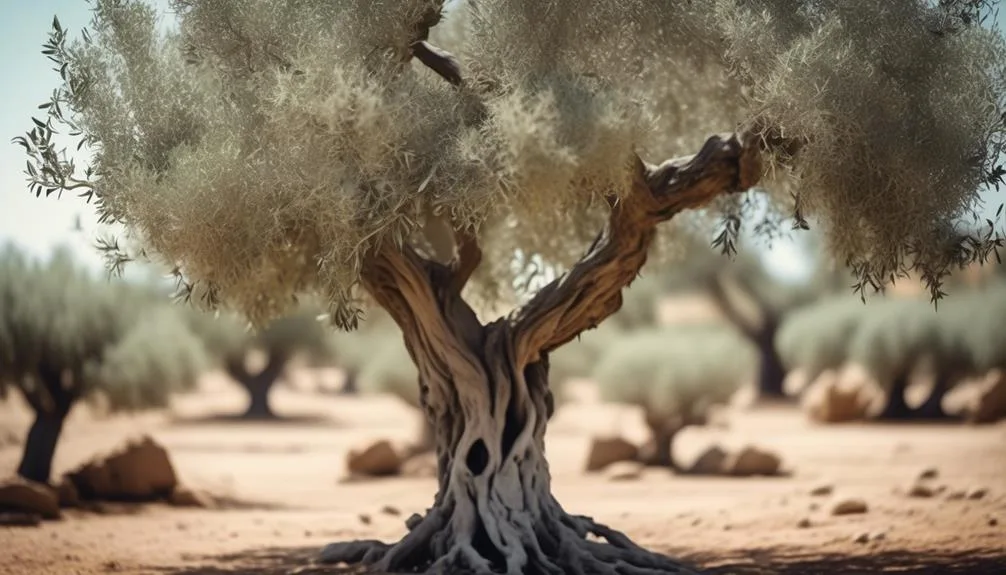Olive trees are amazing – they can survive with just 8 inches of rain a year! They're tough in dry places, but how?
People have always admired how olive trees can handle not having much water. Figuring out their secrets could help us with farming and taking care of land.
So, what's their trick to dealing with drought?
Key Takeaways
- Olive trees have developed mechanisms to withstand drought, such as deep root systems and water-conserving leaf structures.
- Specialized irrigation techniques, like controlled deficit irrigation and mulching, play a significant role in enhancing olive trees' resilience to arid conditions.
- Olive trees possess adaptive features, such as a waxy coating on their leaves and the ability to adjust their root systems, allowing them to thrive in drought conditions and continue producing fruit.
- Proper soil moisture management and irrigation practices are crucial for maintaining olive trees' resilience to drought, and understanding their adaptive strategies can contribute to sustainable agricultural practices in regions prone to drought.





Olive Trees and Drought Tolerance
Olive trees have developed remarkable mechanisms to withstand drought, making them a fascinating subject for understanding how plants adapt to arid conditions. These trees have evolved to prioritize water conservation, with their roots reaching deep into the soil to access water reserves.
To further enhance their drought tolerance, olive trees have also developed unique irrigation techniques, such as maximizing water uptake during periods of rainfall and minimizing water loss through specialized leaf structures.
Their ability to thrive in arid climates isn't only a testament to their resilience but also provides valuable insights for agricultural practices in dry regions. By studying the water-saving strategies of olive trees, researchers and farmers can gain knowledge that may contribute to more sustainable and efficient irrigation methods for various crops, helping to combat the challenges of water scarcity.
Factors That Make Olive Trees Resistant
When considering the factors that contribute to the resilience of olive trees, their deep-reaching roots and specialized irrigation techniques stand out as key elements in their ability to withstand drought. The deep root system of olive trees allows them to access water from deep within the soil, making them less dependent on surface water during dry periods. Additionally, the specialized management techniques used in olive tree cultivation, such as controlled deficit irrigation and mulching, play a significant role in their adaptation to arid conditions. These factors collectively contribute to the olive tree's remarkable ability to thrive in regions with limited water availability.





| Factors | Adaptation | Resilience |
|---|---|---|
| Deep roots | Efficient water usage | Drought tolerance |
| Specialized irrigation | Adaptation to arid conditions | Sustainable growth |
The deep roots and specialized irrigation techniques are fundamental aspects of olive tree management that enhance their resilience and enable them to adapt to challenging environmental conditions.
How Olive Trees Adapt to Drought
To thrive in drought conditions, olive trees employ a range of adaptive strategies that allow them to efficiently utilize water and maintain sustainable growth.
One key mechanism is their ability to retain water. The leaves of olive trees have a waxy coating that reduces water loss through transpiration, helping them conserve moisture during dry periods.
Additionally, olive trees have deep and extensive root systems, which aid in water absorption and storage. Their roots can reach deep into the soil to access water sources that are unavailable to other plants.





Moreover, olive trees have the remarkable capacity for root development. They can adjust their root systems to explore larger soil volumes, further enhancing their ability to withstand drought.
These adaptive features collectively enable olive trees to thrive in arid conditions and continue producing their valuable fruit.
Strategies for Managing Drought Stress in Olive Trees
Implementing proper irrigation techniques and mulching the soil can significantly aid in managing drought stress in olive trees, ensuring their continued health and productivity.
To effectively manage drought stress in olive trees, consider the following strategies:
- Irrigation Techniques:
- Use drip irrigation to deliver water directly to the base of the trees, minimizing evaporation and ensuring efficient water use.
- Schedule irrigation during the cooler parts of the day to reduce water loss through evaporation and ensure optimal uptake by the trees.
- Soil Management:
- Apply mulch around the base of the trees to conserve soil moisture, regulate soil temperature, and suppress weed growth.
- Consider incorporating organic matter into the soil to improve its water-holding capacity and enhance overall soil structure.
Conclusion: Olive Trees' Resilience to Drought
Understanding the remarkable resilience of olive trees in the face of drought can provide valuable insights for sustainable agricultural practices.
Olive trees have evolved to withstand drought through their ability to extract water from deep in the soil, their efficient use of water, and their capacity to enter a dormancy state during prolonged dry periods. This resilience makes olive tree cultivation particularly suitable for regions with limited water availability.
In conclusion, the key to maintaining olive trees' resilience to drought lies in effective soil moisture management and efficient irrigation practices. By carefully monitoring and managing soil moisture levels, and implementing appropriate olive tree irrigation techniques, farmers can ensure the continued health and productivity of olive trees even in challenging arid conditions.
This understanding can significantly contribute to sustainable agricultural practices in regions prone to drought.
Conclusion
In summary, olive trees' resilience to drought, with their deep roots, waxy leaves, and adaptive stomata, makes them a valuable crop in water-scarce regions.
Their ability to thrive in arid conditions highlights the importance of sustainable management strategies.
How can we learn from their resilience to address broader challenges of water scarcity in agriculture?

